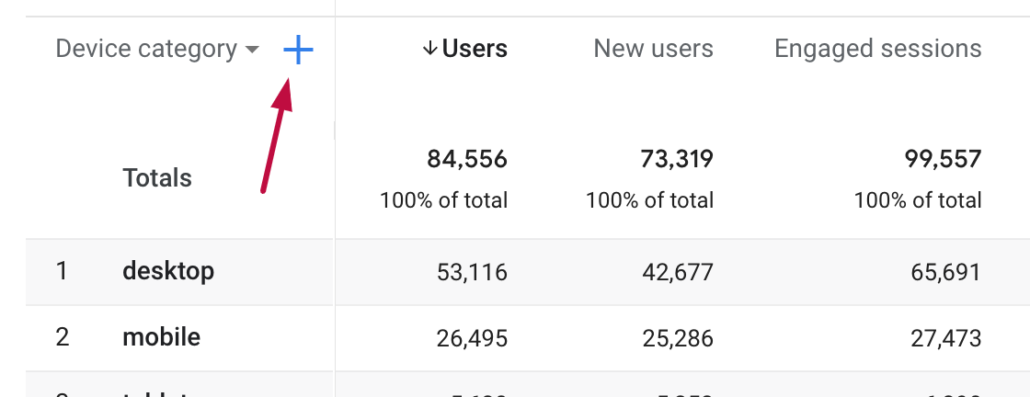Transform Your Analytics Approach With Additional Dimension in Google Analytics
By incorporating additional measurements into data evaluation, a brand-new layer of insights arises, dropping light on intricate customer behaviors and communications. The critical application of additional dimensions holds the key to unlocking a prize trove of invaluable info that can reinvent just how companies act and analyze upon their data.
Comprehending Secondary Measurements in Google Analytics
Additional dimensions in Google Analytics give additional context to key data by allowing users to examine metrics across a second dimension, providing deeper understandings right into user habits and communications on a web site. Secondary Dimension in Google Analytics. While primary measurements offer essential information factors such as pageviews, bounce price, and session duration, second measurements use a more detailed sight by segmenting the main information even more. This segmentation allows customers to evaluate metrics in combination with an additional dimension, such as web traffic sources, demographics, or individual behavior
Benefits of Making Use Of Second Dimensions
Using additional measurements in Google Analytics supplies a critical benefit by enhancing the depth of evaluation and supplying a more comprehensive understanding of individual communications and behavior on a website. By including second dimensions, analysts can acquire valuable insights right into the performance of certain sections or variables within their data. This enables an extra thorough exam of customer actions past surface-level metrics, enabling a much deeper exploration of the variables affecting individual interaction and conversions.

Just How to Execute Secondary Dimensions
When integrating secondary dimensions in Google Analytics, one essential action is to choose the relevant metrics and measurements to improve the evaluation procedure. Clicking on this switch will certainly open up a drop-down food selection listing different dimensions that can be added to your primary dimension for deeper insights.
After selecting the ideal secondary measurement, such as 'Source/Medium' or 'Device Classification,' Google Analytics will certainly display the information in a more comprehensive style, allowing you to cross-analyze various facets of user habits. Bear in mind to experiment with various mixes of second and main measurements to reveal beneficial patterns and trends that can inform your advertising and marketing strategies. By implementing second dimensions thoughtfully, you can obtain a much more thorough understanding of your internet site or application efficiency and make data-driven choices to enhance your electronic visibility.
Studying Data With Second Dimensions
Boost your data analysis in Google Analytics by incorporating additional dimensions to dig much deeper right into customer behavior patterns and enhance your electronic marketing that site techniques successfully - Secondary Dimension in Google Analytics. By including secondary dimensions to your main data, you can gain useful insights that can help you make educated choices about your internet site or application efficiency
Examining information with secondary dimensions allows you to sector your main information better, offering an extra comprehensive view of user communications. Integrating the key measurement of 'source/medium' with a second measurement like 'landing page' can disclose which particular pages are driving web traffic from different resources. This info can be critical in refining your material strategy or optimizing your ad campaign to boost conversions.
Additionally, utilizing secondary dimensions allows you to determine connections between various metrics, aiding you recognize the effect of various aspects on individual habits. Whether it's examining demographics along with user interaction metrics or gadget groups with conversion prices, additional dimensions encourage you to uncover covert trends and patterns that can guide your marketing initiatives.
Optimizing Efficiency With Second Dimensions
To boost the effectiveness of information evaluation and decision-making in Google Analytics, including second click here now dimensions is crucial to optimizing efficiency metrics and gaining deeper understandings right into user actions patterns. By using second measurements, analysts can dive beyond surface-level data and reveal valuable connections that may otherwise go undetected. This optimization technique makes it possible for companies to customize their advertising and marketing initiatives better, determine areas for enhancement in site functionality, and enhance general customer experience.
Second dimensions provide an even more detailed view of customer communications by supplying added context to key data metrics. Combining the main dimension of 'touchdown page' with an additional dimension like 'tool group' can disclose whether particular gadgets are more likely to drive involvement on particular touchdown pages. This understanding can inform responsive design improvements or targeted advertising and marketing strategies to enhance efficiency.

Verdict
In conclusion, the combination of secondary dimensions in Google Analytics gives services with a powerful tool to enhance their analytics approach. Secondary Dimension in Google Analytics. By delving deeper into individual habits and interactions, marketers can discover valuable understandings that can drive performance optimization and improve the overall customer experience. Leveraging secondary dimensions enables for an extra comprehensive analysis of data, causing even more educated decision-making and customized marketing initiatives
Additional dimensions in Google Analytics give extra context to main data by permitting customers to assess metrics throughout a second measurement, using deeper site understandings into customer actions and interactions on a website. While key dimensions provide basic data factors such as pageviews, bounce price, and session period, secondary measurements offer a more in-depth view by segmenting the main data even more.One of the key advantages of using additional dimensions is the capacity to uncover relationships and patterns that may not be immediately evident when evaluating information with primary dimensions alone.When incorporating secondary measurements in Google Analytics, one vital step is to pick the pertinent metrics and dimensions to enhance the analysis process. Combining the primary dimension of 'touchdown web page' with a second dimension like 'gadget classification' can disclose whether specific gadgets are a lot more most likely to drive involvement on details landing web pages.
Comments on “Mastering Secondary Dimension in Google Analytics: A Complete Overview”